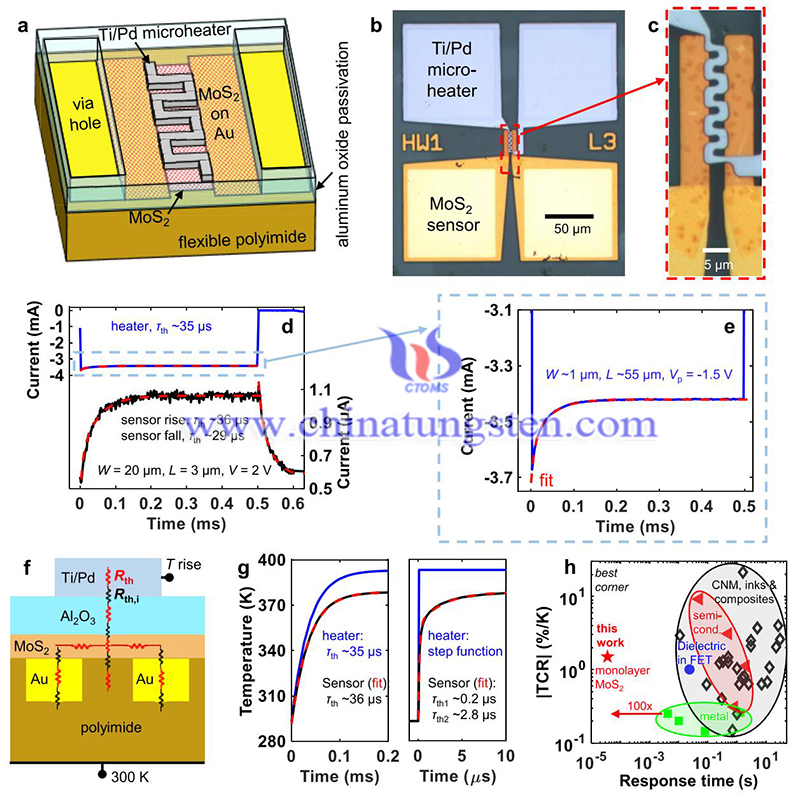MoS2 for Flexible Sensor to Detect Real-Time Temperature
- Details
- Category: Tungsten's News
- Published on Thursday, 04 August 2022 23:43
A recent study published in Nano Letters addresses the issue of real-time temperature detection sensitivity by building a flexible sensor from a monolayer of molybdenum disulfide (MoS2) capable of sensing temperature changes within a few microseconds, about 100 times faster than the commonly used thin-film metal detectors.
Real-time temperature detection using flexible sensors can open up a variety of new possibilities. Obtaining fast, sub-millisecond response times with flexible sensors is a major challenge due to the limited thermal capacity of the materials being detected and encapsulation issues.

(Image Credit: Sambulov Yevgeniy/Shutterstock.com)
Temperature is the most fundamental physical variable that reflects the condition of the object under test and its surroundings, fluctuating with time and location. Temperature control is critical in everyday and industrial environments, and real-time temperature sensing has received increasing attention in recent years.
Many biomedical systems, contamination management, and safety-critical machine control systems require fast and reliable thermal readings. Flexible sensor assemblies often need to be attached directly to human tissue or curved surfaces for consistent and accurate data readings in real-time thermal detection systems.
Therefore, the implementation of next-generation temperature detectors on an extremely thin, homogeneous, and flexible platform is essential for enhanced interaction with biomaterials and easy implantation of sensors in biodegradable packaging or electrical components.
Flexible temperature sensors based on two-dimensional (2D) materials have recently shown great promise in a variety of applications, including portable electronics, robotic systems, medical services, and prosthetics. Due to the non-toxic and biocompatible nature of many 2D materials, flexible sensors based on these materials can be used for real-time thermal sensing in implantable electronics.

(Image Credit: Alwin Daus/NANO Letters)
Two-dimensional (2D) nanomaterials, such as graphene and carbon nanotubes (CNTs), have recently emerged as promising candidates for flexible thermal detectors with exceptional responsiveness. However, two-dimensional (2D) semiconductors like molybdenum disulfide (MoS2), which are virtually unexplored for such applications, have not received much attention.
Recent studies of molybdenum disulfide by researchers have shown that it has great potential as a novel sensing material. Molybdenum disulfide has excellent cytocompatibility and a high thermal coefficient of resistance (TCR), but its real-time sensing efficiency and array integration capabilities have yet to be investigated. In this study, researchers used a recently developed direct transfer technique to fabricate a flexible sensor for fast and accurate thermal detection from atomic-scale molybdenum disulfide.
To achieve this sensor, chemical vapor deposition is used to create a consistent single-layer molybdenum disulfide sheet. Gold contacts are deposited and the molybdenum disulfide coating is structured before the molybdenum disulfide film is transported to a flexible platform. A 5-micron thick bendable polyimide (PI) substrate is then spin-coated on the surface. This results in a molybdenum disulfide surface with particularly low surface roughness.
The researchers also constructed 4x4 MoS2 temperature detector panels to illustrate the feasibility of this unique material in producing low-cost flexible sensors for real-time temperature monitoring.
The researchers found that the thermal response time of the fabricated flexible sensor was 36 microseconds, many orders of magnitude faster than the thin-film metal sensors traditionally used. Thermal analysis showed that the molybdenum disulfide contact and encapsulation completely limited the response time of the sensor. The operation was stable during cycling, with long-term thermal measurement capability when capped with aluminum oxide.
The contact of the molybdenum disulfide surface with air and moisture usually takes a few minutes to settle, which can be attributed to the continuous increase in conductivity of the uncapped sensor after heating. On the other hand, the alumina capping is sufficient to passivate the molybdenum disulfide surface and stabilize the response of the resulting flexible sensor.
In summary, fast temperature detection is critical for real-time readout of large panels, for example, to detect sudden temperature changes at the microsecond level in power electronics to avoid mechanical damage. This research allows the development of real-time temperature sensors using atomic-level semiconductors like MoS2.
Reference: Daus, A., Jaikissoon, M., Khan, A. I., Kumar, A., Grady, R. W., Saraswat, K. C., & Pop, E. (2022). Fast-Response Flexible Temperature Sensors with Atomically Thin Molybdenum Disulfide. Nano Letters. Available at: https://pubs.acs.org/doi/10.1021/acs.nanolett.2c01344
(Source: NANO Letters)
| Molybdenum Supplier: Chinatungsten Online www.molybdenum.com.cn | Tel.: 86 592 5129696; Fax: 86 592 5129797;Email:sales@chinatungsten.com |
| Tungsten News & Prices, 3G Version: http://3g.chinatungsten.com | Molybdenum News & Molybdenum Price: http://news.molybdenum.com.cn |



 sales@chinatungsten.com
sales@chinatungsten.com